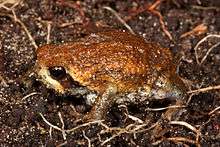Breviceps bagginsi

| Breviceps bagginsi | |
|---|---|
| Scientific classification | |
| Kingdom: | Animalia |
| Phylum: | Chordata |
| Class: | Amphibia |
| Order: | Anura |
| Family: | Brevicipitidae |
| Genus: | Breviceps |
| Species: | B. bagginsi |
| Binomial name | |
| Breviceps bagginsi Minter, 2003 | |
Breviceps bagginsi (Bilbo's rain frog) is an amphibian species in the Brevicipitidae family, endemic in South Africa.[2] It was named after Bilbo Baggins, because the scientist who discovered it used to read The Hobbit to his children.[3] Its natural habitatsare temperate grassland and edges of wood plantations. The species threatened by habitat loss is listed as vulnerable (VU) in the IUCN Red List of Threatened Species.[1]
Description
Breviceps bagginsi is a mycrohylid (narrow-mouthed) frog from the family of Brevicipitidae discovered in the year 2003. The body size of male individuals varies from 20-25.9 mm and females measure approximately 28.7mm in length.[4] With its highly truncated snout it is well adapted to its burrowing lifestyle. They have a characteristic tympanic membrane and their pupil is horizontally ecliptic.
The dorsum of Breviceps bagginsi has a medium to dark brown, fairly granular skin texture with darkly pigmented tubercles, each containing openings of 2-6 dermal glands. The ventrum is smooth and of light color. From the eye to the origin of the arm Breviceps bagginsi have a black stripe. They have a lighter bar between the eyes and a white stripe from the lower eyelid to the mouth. The sides of the body are brown with a few white spreckles.[4]
As all species from Brevicipitidae, Breviceps bagginsi lack sphenethmoids.[5]
Distribution, habitat and ecology
Breviceps bagginsi only occur in South Africa. They live on edges of wood plantations in Kwazulu-Natal midlands of southeastern South Africa, along the mist belt from Boston in the west to Melmoth, in the north-east and down to the coast at Mkambati. They occur in an elevation range from 25 to 1400 m asl (meters above sea level).[6]
The Mkambati area is protected due to its biodiversity and therefore high conservation value. The Breviceps bagginsi population in this area lives in undisturbed grasslands.[6][7]
Behavior
As a member of the genus Breviceps, Breviceps bagginsi shows sexual dimorphism. The males are much smaller than the females. Unlike other frogs Breviceps males have very short limbs relative to their body size. Therefore, they are not able to amplex the females while the process of mating, but with an adhesive secretion they can adhere to the body of the female.[8]
Their advertisement call has two different call bouts, both at a frequency of 2552 HZ.[4]
Breeding occurs in subterranean nests.[6] Offspring hatches fully developed from eggs directly.[5]
Status
On the IUCN Red List of Threatened Species Breviceps bagginsi was listed as data deficient until 2010. In 2010 it was relisted as vulnerable (VU) because of the small area of occurrence (11'000 km2) and the declining area of occupancy, which is only 10% of the occurrence (1'100 km2). Although their occupancy is declining, their occurrence remains the same. Furthermore, Breviceps bagginsi live in extremely fragmented subpopulations and the quality of their habitat is decreasing due to sylviculture and construction and maintenance of roads.
Subpopulation sizes are around 20-30 individuals. Distances between subpopulations are too long to allow dissemination within one generation.[6]
References
- 1 2 South African Frog Re-assessment Group (SA-FRoG); IUCN SSC Amphibian Specialist Group (2010). "Breviceps bagginsi". IUCN Red List of Threatened Species. Version 2013.2. International Union for Conservation of Nature. Retrieved 30 November 2013.
- ↑ Frost, Darrel R. (2013). "Names described as 'Breviceps bagginsi'". Amphibian Species of the World: an Online Reference. Version 5.6 (9 January 2013). Retrieved 30 November 2013.
- ↑ Joubert, Leonie Skene (2006). Scorched: South Africa's Changing Climate. Wits University Press. p. 86. ISBN 1868144372. Retrieved June 15, 2015.
- 1 2 3 Minter, Leslie R. (31 Aug 2010). "Two new cryptic species of breviceps (Anura: Microhylidae) from Southern Africa". Taylor & Francis.
- 1 2 "AmphibiaWeb - Brevicipitidae". amphibiaweb.org. Retrieved 2016-04-08.
- 1 2 3 4 "IUCN Red List of Threatened Species, Breviceps bagginsi". www.iucnredlist.org. Retrieved 2016-04-06.
- ↑ Thembela, Kepe (March 1999). "Creating Grasslands: Social Institutions and Environmental Change in Mkambati Area, South Africa". Human Ecology.
- ↑ "Breviceps bagginsi". AmphibiaWeb.
